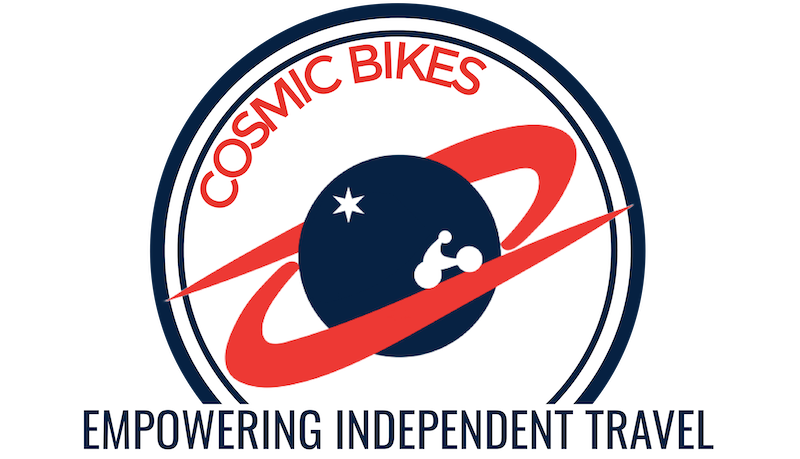COSMIC BIKES ONLINE CATALOG
RECUMBENT BIKES & TRIKES
Summary
-
Recumbents offer a comfortable, ergonomic ride, thanks to a semi-reclined seat with full back support, and cranks that extend in front of the rider. Because they eliminate the typical pain points of riding a bicycle, they make it possible to cover longer distances without discomfort, and can be a good solution for riders with physical challenges due to illness, injury or age.
-
Recumbents are available in two-wheel and three-wheel configurations. Within these two categories, there’s a tremendously wide range of option having to do with wheel size wheel placement, seat height, steering placement, crank height and more. E-assist is available on many models.
-
Analog models from $1500
E-Assist from $3350
Specialty builds, upgrades and adaptive modifications can run quite a it more. -
Recumbents are a great solution for anyone who wants to cycle without the typical discomfort, such as are wrists, neck and back.
Trikes especially an be a perfect solution for anyone with physical limitations, and can allow people to stay active if regular cycling or exercise becomes difficult or impossible.
Recumbents are the perfect choic for recreational riding, log distance touring, and expedition-style touring. -
In-stock Items available immediately. Most Special Order items arrive within 5-10 days.
AZUB MAX
Dual 26” wheels
Below seat steering
Semi-reclined seat
High crank position
CATRIKE 5.5.9
Tadpole trike with 26”/20” wheel combination
Semi-reclined seat
Moderate crank position
HASE TRIGO UP
Delta trike with three 20” wheels
Upright steering
High seat position with lower cranks
Electric assist
HASE KETTWIESEL
Folded for transport.
More About Recumbent Design
On a recumbent bike, your body isn’t resting on your sit bones and your hands, like it is on a regular bike. You ride in a semi-reclined position on something that looks very much like comfortable seat, with your legs in front of you. Your body’s weight is distributed over a wider area, with excellent hip and back support, and angles that make your neck happy.
While all recumbents offer the ergonomic, semi-reclined rider position, there’s also a lot of variety among the various designs, models and applications.
Wheel configuration
Two-wheel recumbents
Short wheelbase (SWB) recumbents have the front wheel tucked behind the cranks, below the rider’s calves. SWB recumbents generally also have a higher crank position (see below) are quite agile and responsive, and generally more performance-oriented, as well as easier to transport.
Long wheelbase (LWB) recumbents have the front wheel in front of the cranks, and a lower crank position. They are a bit easier to get on and off, and offer stability over long distances. However, they can be more cumbersome to transport.
Recumbent Trikes
Delta trikes have two wheels in the rear and one wheel in front, used for steering. Pedaling drives one or both of the rear wheels. They are generally easier to get on and off, plus they offer excellent stability and tight cornering. They are relatively easy to walk with, and some can be parked or stored upright.
Tadpole trikes have one wheel in the rear and two wheels up front, which are used for steering. Pedaling drives the rear wheel. The seating position is generally a bit lower than on a delta trike, and mounting and dismounting is a bit trickier. A growing number of tadpole trikes feature a moderately high seat, and features that make them more accessible to older people, larger riders, or those with limited mobility. There are also performance tadpole trikes with very low, almost fully reclined, seats.
Wheel size
Recumbent bikes and trikes generally use 20” and 26”, sometimes in combination. Less often, 700c wheels are used.
Delta trikes usually have 20” wheel all around
Tadpole trikes can have three 20” wheels, 20” in front and a 26” (sometimes 700c) in the back, or 26” wheels all around.
LWB two-wheelers usually have a large 700c or 26” wheel in the back, and a 20” wheel in the front
SWB recumbents run the gamut with dual 20” wheels, 700c/26” wheel combo, and even dual 26” or 700c setup found on high-racer recumbents.
Larger wheels are thought to be faster-rolling and offer better protection from bumps in the road. However, smaller wheels provide more maneuverability and agility, and can make the bike more portable. They are also an excellent choice for smaller riders.
Seat Height & Crank Position
Seat height determines how easy the bike is to get on and off from. However, once seated, the relationship between the seat and crank position affects how the bike will feel. More casual and recreational recumbents tent to have a lower crank position relative to the seat, and performance-oriented models feature higher cranks.
Steering
Trikes: Tadpole trikes have steering handles positioned on the sides, slightly above (for tadpole trikes), and slightly below (for delta trikes) the rider’s hips. Some delta trikes are also available with upright steering, with handlebars positioned in front of the rider’s chest.
Two-wheelers usually feature above seat steering, but below seat steering is available on select models, and it is a very comfortable option.
Other options
Suspension: front and rear suspension is available on many recumbent models, and can make for a luxurious ride. It’s especially useful if you like riding over unpaved trails.
Folding: many recumbent trikes feature a folding frame, and/or removable seat and wheels for easier transport.
E-Assist: electric assist is available as an upgrade or standard on many recumbents.





